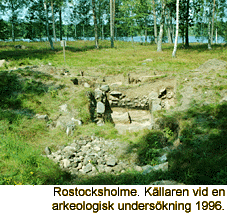Meet the Middle Ages
BackRostocks holme

During the Middle Ages a large fortified manor lay on an islet in the Lyckeby river, between the lakes Grimmansmålasjön and Rostocksjön. It was called Rostocks Holme. Rostock means border - bridge. The manor house lay between two districts - Möre and Värend - and two dioceses - Linköping and Växjö. It also lay near the borders of two countries - Sweden and Denmark. The main commercial route between the coast of Blekinge and central Värend passed Rostocks Holme as well.
The stronghold was established in the middle of the 14th century, probably by Bishop Tomas in Växjö. Being in charge of Rostocks Holme meant that he could control the trade between Växjö and the coastal regions of Blekinge. Trade was at this time made easier, because until 1360, Blekinge was Swedish.
The Bishop owned several estates in the region. The peasants paid taxes to him and his estate. Now and again they probably were called upon to do labour at the manor. A number of guards controlled the surroundings to make sure that all was calm.
On the islet, one can still see the foundations of the main dwelling. The manor house had a stone cellar where taxes – that is, food supplies - were kept. The upper storeys of the house were built of wood. Nearby, there were five smaller buildings; these were for the servants and craftsmen as well as for the cattle. The entire establishment has burned down or maybe has been set fire to at the beginning of the 15th century.
Archaeological excavations reveal interesting finds which tell us a lot about life on the manor. Amongst these are pieces of pottery from cups or dishes, large quantities of burned grain from the cellar, a horse-shoe and a die to play games with. Parts of a shield indicate that people were prepared to defend themselves.